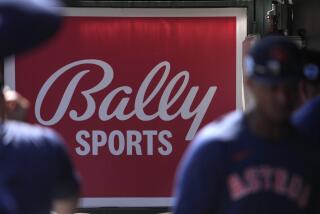Cable flips channel on public access TV
For decades, public access programming on cable television has provided a virtually free forum for community activists and aspiring entertainers, for preening star wannabes as well as serious-minded political watchdogs.
But in Los Angeles and across California that forum began crumbling last week, a development that advocates say will strip ordinary citizens of a valuable 1st Amendment platform.
A provision of a law passed by the Legislature in 2006, which took effect Thursday, allows cable television providers the option of dropping their long-standing obligation of providing free studios, equipment and training to the public. In return, providers must pay a substantial annual fee and continue to provide a minimal number of public education and government channels.
The new law is designed to make it easier for phone companies to enter into the lucrative cable market by relieving them of certain money-draining contractual obligations.
In Los Angeles, 12 public access studios that provided programming for 11 community channels have been closed by Time Warner Cable Inc. That means much of the city’s diverse, neighborhood-specific public access shows may disappear.
If that happens, Los Angeles cable subscribers would be losing an outlet for their particular communities’ programming, said David Hernandez, president of the Los Angeles Public Access Coalition.
“It’s the regional broadcasting capability that’s lost,” he said.
Twenty other states, including Texas, Nevada, Florida, Illinois and Michigan, have enacted legislation similar to California’s Digital Infrastructure and Video Competition Act, or DIVCA, according to the nonprofit Alliance for Community Media. In several of those states, the loss of production studios was bitterly fought by opposition groups to little avail.
But the waning of public access programming in California would carry special significance for the nation, said Ron Cooper, a public access advocate and regional treasurer of the Alliance for Community Media in Sacramento.
“The rest of the country is watching,” Cooper said. “And not because it’s a good example -- quite the opposite.”
In Los Angeles, public access covers an array of citizen-produced shows, including “Soul & Sound of Watts,” “East L.A. After Dark” and a late-night program by sexologist Dr. Susan Block. Between 30% and 35% of all programming is religion-oriented.
Although public access television often is mocked as a showcase for eccentric narcissists and sensationalistic provocateurs -- what Cooper referred to as “naked Nazis” -- he said only a small proportion of its content fits this bill.
“For the city of Los Angeles, the city of angels, the media capital of the world to say there is no room for public” access, Cooper said, “I don’t even know how to describe it.”
Time Warner says it is only complying with the provisions of the new law, which still requires a limited number of public, government and education channels funded by a fee calculated by 1% of gross annual revenue. In Los Angeles, that fee for Time Warner amounts to about $5 million, which is in addition to a $25-million annual franchise fee.
“The spirit of DIVCA was to create a level playing field for all competitors,” said Patricia Fregoso-Cox, vice president of communications for Time Warner Cable for the western region.
Fregoso-Cox said the company would continue to reserve four area cable channels for so-called PEG (public, education and government) content and that it had no plans to convert those to commercial programming. One city-run public access studio, in Boyle Heights, will remain open, at least for now.
As for the 12 studio closings, she said: “We have an exit strategy. Some of the buildings we own, some of the buildings we lease. Some of the buildings will be repositioned for other programming.”
In Los Angeles, the cavalcade of characters, gadflies and watchdogs that populate the public access channels aren’t going away without a fight. Hernandez has written to City Atty. Rocky Delgadillo and California Atty. Gen. Jerry Brown to ask for injunctive relief against the studio closings.
“It’s a two-pronged immorality,” said Leslie Dutton, executive producer and host of the Full Disclosure Network, an Emmy-winning public access news broadcast.
“It’s immoral for the city to do nothing to replace the assets that are being taken from the public with the millions of dollars that are still coming to them, and No. 2, for preventing Time Warner from closing the channels down.”
Dutton and others say there is no guarantee that any of the four PEG channels will be used for public access programming. They also say that neither Time Warner nor the city gave adequate public notice of the studio closings.
“There wasn’t a flier or a handout or anything telling what this was,” said Rob Baker, producer of “The John Kerwin Show,” a celebrity-oriented talk program that taped what could be its last episode Dec. 17. “Nobody knew that public access is hearing its death knell.”
On the contrary, Fregoso-Cox said, “this isn’t something that hasn’t been communicated, that people aren’t aware of.”
The closing of the city’s studios is only one consequence of a nationwide campaign by phone companies -- including AT&T; Inc., Verizon Communications Inc. and Qwest Communications International Inc. -- to move into the cable market.
Many cable providers, meanwhile, are trying to compete in the phone market by bundling services (cable, phone, Internet), resulting in an escalating turf battle among powerful multimedia companies seeking control over a growing universe of information-delivery systems.
California’s legislation, drafted by then-Assembly Speaker Fabian Nunez, a Los Angeles Democrat, was signed into law by Gov. Arnold Schwarzenegger in September 2006. Nunez said the law would increase competition and lower cable subscribers’ rates, a contention challenged by consumer groups.
Public access advocates acknowledge that YouTube and other Internet-based platforms have given new outlets for citizen expression. But, they point out, YouTube doesn’t provide free professional studios, equipment and training, nor does it pay for the staff to run the facilities.
Furthermore, Hernandez said, because public access television “is a public asset already, why should the public give up something that belongs to them?”
Public access advocates in Los Angeles and other California cities won’t have an easy time getting back in the studio. Cities are broke, and Los Angeles officials question whether the funds exist to help offset the studio closings.
A city report estimates that the annual cost of staffing and operating a 12-studio system would be $2.7 million, plus a one-time $4.5-million equipping cost, excluding rent.
“We’re looking at a year in which we’re looking at a $400-million deficit,” said Jose Cornejo, chief of staff for Councilman Tony Cardenas.
Cornejo said Cardenas and other City Council members had been scrutinizing the effect of the new law for many months and concluded that their hands were tied by the state.
The council therefore decided to adopt the recommendations of a report by the Board of Information Technology Commissioners. The report said the city should consolidate its control over the four remaining channels so they wouldn’t revert back to Time Warner’s management, as would be possible under the new law, Cornejo said.
“Time Warner is saying, ‘I now can do this. Go fly a kite, council,’ ” Cornejo said. “They usurped our jurisdiction with DIVCA.”
Councilman Bill Rosendahl, a former cable executive, said he supported public access as a 1st Amendment right and “an electronic soapbox.”
He favors studying whether it would be possible for the city to dedicate more funding toward it. But he said the city must address many pressing financial needs.
“We’re in this spot not because the city of Los Angeles created it but because the Legislature did,” he said.
--
More to Read
The biggest entertainment stories
Get our big stories about Hollywood, film, television, music, arts, culture and more right in your inbox as soon as they publish.
You may occasionally receive promotional content from the Los Angeles Times.











